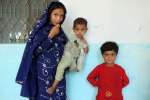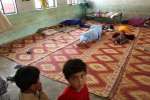One family's experience of war
News Stories, 15 June 2009
PESHAWAR, Pakistan, June 15 (UNHCR) – Some days ago, I went to a hospital in Peshawar to meet people from North West Frontier Province's Swat district who had been injured and who subsequently lost their homes. Their stories do not make the headlines, unlike the number of displaced or the number of combatants killed. But they are part of our human story.
I had not clearly pictured in my mind what I would see when I went to the hospital. I expected amputations and fractures. Instead, I saw bodies completely burned, open wounds, children's faces that had lost their pigmentation, a baby's burned feet. I heard the crying of women and children in pain.
Sapla* is a young mother from Balogram in the Swat Valley whose family used to raise dairy cattle and other livestock. The 25-year-old is in a hospital room with her three surviving children. Her back and breasts are cracked with severe burns. She has open wounds on her legs and arms and her face is bruised. A 16-year-old sister-in-law speaks to herself in one corner, incoherent with pain.
Breathing deeply, Sapla recalled what happened. "It was dusk. We were nine people in a room, reciting prayers. My husband and my father were milking the cows outside in the field. My mother-in-law was with me in the room, she was making bread. A first bomb landed in front of the house. Very soon after, a second and third bomb hit the room where we were."
Sapla told me she was confused. "The room was dark. I could not see anything at first. My clothes caught fire. I was like a ball of fire. The roof collapsed. I just wanted to get out. People from the village came right away to help us. They wrapped me up in cloths. I could feel my skin burning. It was unbearable."
The family did a head count and realized the worst. "My three-year-old daughter, Salma;* my mother-in-law, Johara;* and my brother-in-law, Mohamat,* were dead. I could cope with the pain," Sapla said, sobbing, "If only my daughter were alive."
Sapla showed me her three surviving children. They had all been burned and lost skin pigmentation. "My youngest son, Juma,* is two years old. His feet have been burned," the mother said as her boy cried. Seven-month-old Zaima* also wailed as Sapla's sister tried to breastfeed her with unfamiliar milk. Pashmina, a seven-year-old daughter, looked on at her family, lost in thought.
Sapla spent the whole night after the bombing in severe pain. The family could not be evacuated right away to a hospital as there was a curfew and it was too dangerous to move around. They stayed at a neighbour's house, waiting for help. Eventually soldiers allowed them to use a private car to take the wounded to a hospital in Peshawar. "We arrived at the hospital the next day at 11:00pm," recalled Sapla, 24 hours after the bomb destroyed her home.
Their wounds were washed and they were put on a strong analgesic and old antibiotics. But several days ago, doctors stopped the pain-relievers because of side effects such as constant vomiting and the risk of addiction. Sapla remains in pain.
"The hospitals in Peshawar do not have special units for burned people," said Arif,* Sapla's husband, who suffered minor injuries from the bombing. "We want to get her to the Kharian hospital in Punjab because they have a very specialized unit for people who suffer from burns. But it is just so expensive, it is a private hospital and we just don't have the financial means."
When I visited, Sapla was listening as her mother recited the Koran. Displaced families like her's are a challenge for UNHCR. Isabelle Rivolet is a senior UNHCR protection officer in Peshawar. "The immediate response lies in proper medical care," she said of the wounded and displaced. "But their needs, as well as their families', have also to be placed in a context of displacement."
Rivolet said the refugee agency would start by registering them, as "that will allow a continuous follow-up from the moment they are in the hospital until they return home." She said that UNHCR and other protection agencies were working on the identification of such vulnerable cases in order to get specific relief assistance, including psychological support and income-generation activities.
Meanwhile, Sapla does not blame anyone for what happened to her, but admitted that she needs time to heal. "It was just God's will that we had to go through this," she said. "I don't feel angry, but I don't want to go back to Swat now. I need to feel better. And also there is no electricity, no water and no health structures in place." Still, she conceded, "It is too hot here in Peshawar. In Swat, it is much cooler."
* Names changed for protection reasons
By Hélène Caux in Peshawar, Pakistan













































